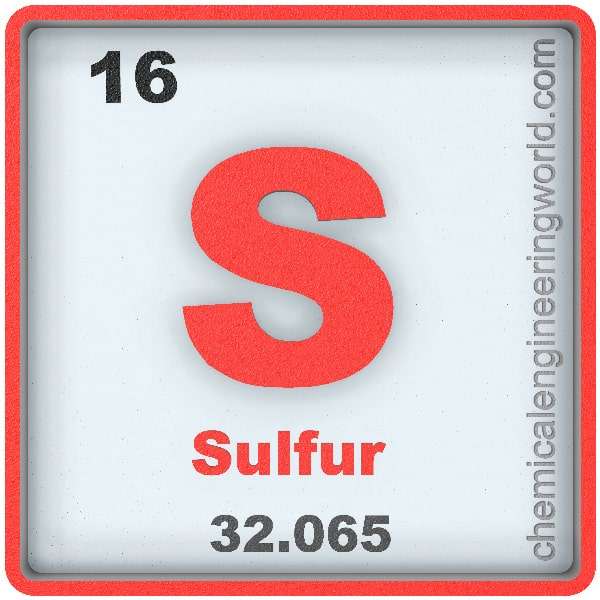Sulphur Element Properties and Information

Sulphur Element Properties and Information:
Sulphur is sixteenth element on the periodic table. Elements are arranged in the periodic table on the basis of the atomic number. Atomic number is the number of protons in the nucleus of the atom. Sulphur has an atomic number of 16. It is located in the Group 16 and Period 3 of the periodic table of elements. It is denoted by S. The name is derived from the Sanskrit word ‘Sulvere’ or the Latin word ‘Sulfurium’.
For centuries sulfur has been used by mankind in some form or the other though sulfur being an element was not investigated untill eighteenth century. Antoine Lavoisier thought that sulphur was an element; Humphry Davy suspected in 1808 that sulphur was not an element and it contained hydrogen. Louis-Josef Gay-Lussac and Louis-Jacques proved that Humphry Davy’s sample of sulphur was impure and also that sulphur is an element in the same year.
Sulphur is tenth most common element by mass in the universe and fifth most common element on earth. Sulphur mostly occurs in elemental form in nature. The major source of sulphur has been near volcanic areas since historic times. Some of the minerals which contain sulphur are galena, iron pyrites, gypsum, and epsom salt; they contain sulphur in the form of sulfide and sulphate minerals.
Physical Properties:
- Sulphur is a tasteless and odourless multivalent non-metal.
- The atomic mass of sulphur is 32.06
- The melting point of sulphur is 113°C
- The boiling point of sulphur is 445°C
- The density of sulphur is 2070 in S.I. units at 20°C
- Sulphur has 23 known isotopes among which sulphur-32, sulphur-33, sulphur-34 and sulphur-36 are stable and sulphur-32 makes up to 94.99% of the total sulphur.
Chemical Properties:
- Sulphur burns with blue flame with formation of sulphur dioxide.
- Sulphur is insoluble in water but soluble in carbon disulphide.
- Sulphur reacts with all the known elements except those elements present in the noble elements group.
- Sulphur reacts with iridium and elevated temperature to form iridium disulfide.
Methods of Production:
- Hydrodesulfurization: Commercially almost all the sulphur is produced from petroleum, natural gas and other fossil resources in the form of hydrogen sulphide. Sulphur is considered an undesirable impurity in petroleum products. Organosulfur compounds present in petroleum are broken by method of hydrodesulfurization. The bond between carbon and sulphur is cleaved and hydrogen sulphide is obtained as a byproduct. The hydrogen sulphide is converted to elemental sulphur by Claus process.
- Frasch process: Historically Frasch process was used to obtain sulphur from fossil deposits in salt domes. Superheated water was pumped in native sulphur deposit in order to melt the sulphur. Compressed air was then used to return 99.5% of pure melted product to the surface. The sulphur obtained required no further purification.
Relevance in Chemical and Related Industries:
- Fertilizer industries: Sulphur is used in fertilizers because it improves performance of other plant nutrients, particularly nitrogen and phosphorus. Calcium sulphate is the form in which sulphur is used in fertilizers because it is difficult for plants to absorb elemental sulphur.
- Fungicides: Elemental sulphur is one of the oldest known fungicides for grapes, vegetables, and many other crops. It has good efficacy against powdery mildew disease and black spots. Sulphur is the only fungicide used in organically farmed apple productions against apple scab disease.
- Insecticides: Elemental sulphur is used as a green insecticide against ticks and mites. A dilute solution of calcium hydroxide and sulphur in water is used as a dip for pets to destroy ringworms, mange and other parasites.
- Pharmaceutical industries: Sulphur is an important ingredient in pharmaceutical formulations to treat acne and other skin conditions because it kills bacteria, fungi, and other parasites. Precipitation sulphur and colloidal sulphur are used in creams, lotions, powdered soap, bath additives etc.
Relevance in Other Industries:
- Furniture: Sulphur was used for decorative inlays to create wooden furniture. After a design is cut, molten sulphur is poured in and then scraped away. The practice has discontinued but sulphur is continued to be used in reconstructed or replica furniture pieces.
Health Effects on Exposure:
- Toxicity: Elemental sulphur by itself is non-toxic but its compounds such as sulphur dioxide and hydrogen sulfide are quite toxic. Hydrogen sulfide is as toxic as hydrogen cyanide and both kill using the same mechanism of inhibiting the respiratory enzyme cytochrome oxidase. Hydrogen sulfide dulls the sense of smell due to which a victim may breath high concentrations of the compound without noticing it.
Effects on Surroundings:
- Inhalation: Elemental sulphur when inhaled causes brain damage, malfunctioning of hypothalamus and also damage to central nervous system of animals.
- Sulphur Dioxide: Elemental sulphur burns to yield sulphur dioxide. Dumping of high concentrations of sulphur dioxide in the environment due to industrial activities will cause the sulphur dioxide to get dissolved in water bodies. The effect is that they inhibit the growth of aerobic bacterias. High concentrations causes harm to lungs, eyes and other tissues.
- Acid Rain: The dumping of sulphur dioxide and sulphur trioxide in environment causes it to mix with water and produce acids. These pour down as rains and damage the environment as well as cause chemical weathering of statues and structure.
References:
































